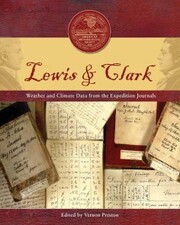Detailansicht
Lewis and Clark
eBook - Weather and Climate Data from the Expedition Journals
ISBN/EAN: 9780933876996
Umbreit-Nr.: 9289375
Sprache:
Englisch
Umfang: 0 S., 22.81 MB
Format in cm:
Einband:
Keine Angabe
Erschienen am 22.01.2013
Auflage: 1/2013
E-Book
Format: PDF
DRM: Digitales Wasserzeichen
- Zusatztext
- By Terry Nathans he weather and climate of the trans-Mississippi west was virtually unknown at the begin- Tning of the nineteenth century. This changed dramatically shortly after the Louisiana P- chase was signed in 1803, which set the stage for acquiring the first systematic weather measurements of the trans-Mississippi west. The framework for obtaining these measurements was outlined in the now famous June 20, 1803 letter from President Thomas Jefferson to his protégé and personal secretary, Captain Meriwether Lewis. In that letter, Jefferson instructed Lewis to plan and carry out an overland expedition to the Pacific Ocean for the purposes of commerce, and to observe and record a broad range of natural history subjects, including the climate, as characterised by the thermometer, by the proportion of rainy, cloudy& clear days, by lightning, hail, snow, ice, by the access& recess of frost, by the winds prevailing at different s- sons, the dates at which particular plants put forth or lose their flower, or leaf (Jackson 1978, p. 63). Jeffersons instructions to Lewis, which were part of his decades-long ambition of laun- ing an expedition to explore the interior of North America, were made at the threshold of what Fleming (1990) has called the expanding horizons in meteorology. During this period, more reliable meteorological instruments began to emerge allowing for a more comprehensive and systematic acquisition of weather data.
- Kurztext
- By Terry Nathans he weather and climate of the trans-Mississippi west was virtually unknown at the begin- Tning of the nineteenth century. This changed dramatically shortly after the Louisiana P- chase was signed in 1803, which set the stage for acquiring the first systematic weather measurements of the trans-Mississippi west. The framework for obtaining these measurements was outlined in the now famous June 20, 1803 letter from President Thomas Jefferson to his protege and personal secretary, Captain Meriwether Lewis. In that letter, Jefferson instructed Lewis to plan and carry out an overland expedition to the Pacific Ocean for the purposes of commerce, and to observe and record a broad range of natural history subjects, including the ...climate, as characterised by the thermometer, by the proportion of rainy, cloudy & clear days, by lightning, hail, snow, ice, by the access & recess of frost, by the winds prevailing at different s- sons, the dates at which particular plants put forth or lose their flower, or leaf... (Jackson 1978, p. 63). Jefferson's instructions to Lewis, which were part of his decades-long ambition of laun- ing an expedition to explore the interior of North America, were made at the threshold of what Fleming (1990) has called the &quote;expanding horizons&quote; in meteorology. During this period, more reliable meteorological instruments began to emerge allowing for a more comprehensive and systematic acquisition of weather data.
- Autorenportrait
- VERNON PRESTON, National Weather Service warning coordination meteorologist in Pocatello, Oregon, compiled this volume of weather and climate data from the Lewis and Clark Expedition in 2004, at the start of the bicentennial anniversary of the Corps of Discovery Expedition (180406). The National Oceanic and Atmospheric Administration (NOAA) published this information as a technical memorandum in 2004 and distributed 100 copies. The American Meteorological Society (AMS) has reformatted the data and explanations of the significance of the expeditions meteorological studies in this volume, which is meant for wider distribution to the public
